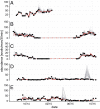Hydrology and density feedbacks control the ecology of intermediate hosts of schistosomiasis across habitats in seasonal climates
- PMID: 27162339
- PMCID: PMC4988578
- DOI: 10.1073/pnas.1602251113
Hydrology and density feedbacks control the ecology of intermediate hosts of schistosomiasis across habitats in seasonal climates
Abstract
We report about field and theoretical studies on the ecology of the aquatic snails (Bulinus spp. and Biomphalaria pfeifferi) that serve as obligate intermediate hosts in the complex life cycle of the parasites causing human schistosomiasis. Snail abundance fosters disease transmission, and thus the dynamics of snail populations are critically important for schistosomiasis modeling and control. Here, we single out hydrological drivers and density dependence (or lack of it) of ecological growth rates of local snail populations by contrasting novel ecological and environmental data with various models of host demography. Specifically, we study various natural and man-made habitats across Burkina Faso's highly seasonal climatic zones. Demographic models are ranked through formal model comparison and structural risk minimization. The latter allows us to evaluate the suitability of population models while clarifying the relevant covariates that explain empirical observations of snail abundance under the actual climatic forcings experienced by the various field sites. Our results link quantitatively hydrological drivers to distinct population dynamics through specific density feedbacks, and show that statistical methods based on model averaging provide reliable snail abundance projections. The consistency of our ranking results suggests the use of ad hoc models of snail demography depending on habitat type (e.g., natural vs. man-made) and hydrological characteristics (e.g., ephemeral vs. permanent). Implications for risk mapping and space-time allocation of control measures in schistosomiasis-endemic contexts are discussed.
Keywords: environmental monitoring; freshwater snails; infection controls; water-based disease.
Conflict of interest statement
The authors declare no conflict of interest.
Figures



References
-
- Lai YS, et al. Spatial distribution of schistosomiasis and treatment needs in sub-Saharan Africa: A systematic review and geostatistical analysis. Lancet Infect Dis. 2015;15(8):927–940. - PubMed
-
- Rollinson D, et al. The Biology of Schistosomes from Genes to Latrines. Academic; Washington, DC: 1987.
-
- Michelson EH. Studies on the biological control of schistosome-baring snails; predators and parasites of fresh-water mollusca: A review of the literature. Parasitology. 1957;47(3-4):413–426. - PubMed
Publication types
MeSH terms
LinkOut - more resources
Full Text Sources
Other Literature Sources
Research Materials
Miscellaneous

